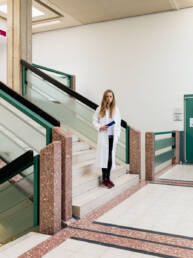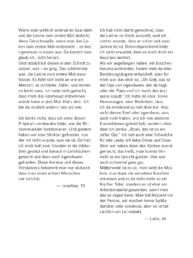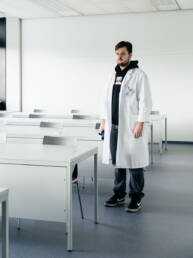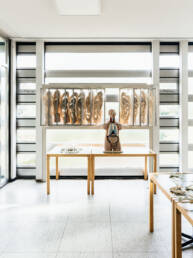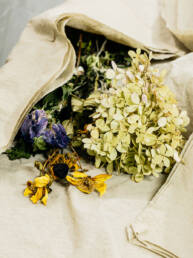BODY DONATION PHOTOGRAPHY – DOCUMENTARY MEDICAL PHOTOGRAPHY
The study of human medicine brings with it a comprehensive and complex field of theoretical knowledge about the structure and function of the human body, which cannot be fully conveyed by anatomical theory alone. In order to get to know each individual structure – muscles, nerves, arteries, veins, organs – and to understand their respective Latin names, functions and the complicated positional relationships among each other, the close examination of the human corpse as a teaching object is an elementary building block of teaching at many medical universities in Germany and worldwide.
In the dissection course, the prospective doctors dissect preserved bodies in small groups over two semesters in order to understand anatomy in combination with lectures and seminars and thus lay the foundation for their professional future on real patients.
The corpses come from body donors – people who, during their lifetime, agreed to donate their bodies to an anatomical institute for teaching and research after their death.
I approached the topic intensively photographically and explored it through this body donation photography project over many months at the MHH Hannover Medical School. In my photo book, which resulted from this project, I bring together the levels of everyday scientific work on and with the corpse, the deceased as a teaching object and the perspective of the first year students with their personal thoughts and feelings.
Medical photography and documentary photography span an atmospherically focused arc over a supposedly invisible but important field of medical teaching by means of a cautious look at the work and emotional side of those involved.
With death as a taboo subject in today’s society, the photo book not only takes a look at the emotional side of body donation and dissection courses, but also encourages the viewer to examine their own perspective of human transience.
The project is mainly characterized by documentary photography and, in its authentical educating form, also functions as a corporate photographic work that gives various groups of people (e.g. prospective students, relatives of body donors) visual access and emotional impressions of the matter.
The story was awarded as one of the four finalist works of the VGH Photo Prize 2022.
GENRE
Documentary Medical Photography
LOCATION
Hannover, Germany
June 2021, in the mortuary of the Institute for Functional and Applied Anatomy at the Hannover Medical School. A sweet, heavy, intense smell of alcohol is in the air. The lifeless naked body of the old lady on the conservation table looks pale, unreal and very small. Her dark gray hair elegant, her mouth open. I have my camera ready to hand, the forensic doctor should be here any moment, says Jana, the dissection assistant.
Today it finally begins. The project had required some persuasion—it is not a matter of course to grant a stranger access to the somewhat outdated cellar with his corpses and their preservation processes, and to have all aspects of the work there photographed.
The coroner enters the room with brisk steps and gets to work. It quickly becomes clear that the body cannot be preserved today, since there are indications of an (although unlikely, but possible) non-natural death. The cause of death must first be clearly established.
Change of plan. The department of pathology, the spacious morgue, includes various areas and rooms that I am exploring for the first time today. Coffin storage, chemical barrels, cold room, fine instruments and heavy tools, cuvettes – dissection assistant Jana presses a button and three dripping corpses are groaningly raised. Their bodies are yellowish, but from looking at them you can’t tell that some of them have been in the alcohol solution for years.
“My” first conservation only takes place weeks later. Thick hoses allow 11 liters of solution to flow into the recently deceased. The gradual discoloration can be observed on the skin. A lower leg is removed, surprisingly non-violently.
A contributor to this project is definitely a certain fascination with what is happening here and what many of us, on the whole, prefer to ignore completely. Most of the people around me react to the project with irritation, amazement or disgust. Death affects us all sooner or later, but dealing with it or even photographing it?
Working in the silent gray basement, between metal, tiles and neon lights triggers completely different things in me – from the beginning it feels like a journey of discovery. There is always something new to be found. In the mini-universe of the institute, I get to know a world that hardly anyone except the employees gets to see, that is deliberately withheld from the public – including donors – and that presents me with new surprises with every visit. Unexplored Territory.
A door leads me from the cold metal cuvettes into the devotional mourning room with a wooden coffin decorated with artificial flowers and electric candles. The large dissection rooms are sometimes empty, sometimes filled with numerous specimens of body parts and organs, sometimes with the corpses covered in white. Sometimes silence, sometimes hustle and bustle.
The cellar and the halls are constantly changing, seeming to have a life of their own, in rhythm with death and its unpredictable schedule on the one hand, and the course of the semester according to the students’ curriculum on the other.
It is obvious that studying medicine must also involve practical experience in order to be able to understand the complex theory of human anatomy. When I happened to find out about the dissection course, it was still a surprising finding: At the beginning of their studies, in the first month, medical students at the MHH are each assigned a preserved corpse in small groups, which they examine every week for months from head to toe, taking apart the whole body, piece by piece, with a scalpel. In this way, they can match every muscle, nerve, every part of the body to the two-dimensional drawings in their dissection atlases and the countless Latin names and eventually fully understand them.
Bodies are donated to the Institute during lifetime for this very purpose (as well as for research and training of doctors and scientists) through so-called bequests, often for altruistic reasons. The range of donations pretty much covers the ongoing needs of the MHH.
The mortal remains are cremated separately at the end of the course and the urns are buried anonymously in a separate grave field in Celle near Hannover. After the course, there is also an annual thanksgiving and commemoration ceremony for the students in the chapel of the MHH. The preparation course is a formative and often emotional experience for the freshmen, which sets the foundation for their professional future. For the portraits, I asked them to imagine the first day of the course and the moment of their first confrontation with the preparation. Annalena’s portrait (on the stairs) was created before the course, the others a few weeks after the first appointment.
The exchange with them gave me valuable insight and an important perspective on the comprehensive overall complex of body donation.
In the prep room and also in the basement, I move freely between scientific work processes and the preparations. Soon trust builds up, I am allowed to freely roam through the Institue, take photos, explore without supervision.
Through the lens I search for aesthetics in the interplay of death, education and science – in my head thoughts are circling in the background. The special smell of the morgue and its preparations accompany me home almost every time, often staying until the evening, like a phantom, a memory or a trick of my senses. My thoughts remain present with them, about life and death, taboo and repression, the meaningfulness and unreality of us and everything.
Julia Bellack, Hanover, 2022

In The Beginning There Is Death. Photo Book. Documentary Medical Photography Hanover & Hamburg





